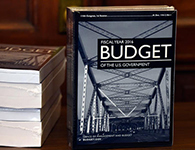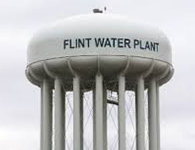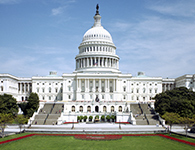Administration’s Budget Signals Shift in Water Investment Priorities
 The Obama Administration released its proposed Fiscal Year (FY) 2017 budget on February 9 signaling a dramatic shift in water investment priorities. While the Administration is touting a proposed $300 million investment in water innovation and water supply, it is also significantly slashing funding to EPA’s Clean Water State Revolving Fund (CWSRF) by over $414 million. This is a surprising and disappointing request in a final budget from an Administration that is trying to make clean water a centerpiece of its legacy, especially in light of the current water crisis playing out in Flint, Michigan.
The Obama Administration released its proposed Fiscal Year (FY) 2017 budget on February 9 signaling a dramatic shift in water investment priorities. While the Administration is touting a proposed $300 million investment in water innovation and water supply, it is also significantly slashing funding to EPA’s Clean Water State Revolving Fund (CWSRF) by over $414 million. This is a surprising and disappointing request in a final budget from an Administration that is trying to make clean water a centerpiece of its legacy, especially in light of the current water crisis playing out in Flint, Michigan.
The proposed cut to the CWSRF pays for other Administration priorities elsewhere in the Administration’s EPA budget, including an increase of $158 million for the Drinking Water State Revolving Fund (DWSRF) program and $240 million more for enforcement efforts. Even in the wake of Flint, the proposed increase to the DWSRF is less than what the Administration proposed last year. While NACWA supports an increase for the DWSRF, there also must be an increase in the CWSRF – especially given EPA’s own recent clean water needs survey showing a $270 billion need for clean water investment. Now is the time to be increasing the federal investment in water infrastructure, not cutting investment. Additional details on the budget request are available in Advocacy Alert 16-03  .
.
The Administration’s budget request also contains funding for a $300 million initiative to invest in water innovation technology focused on dealing almost exclusively with water supply challenges caused by western drought. Monies would fund such things as technology development to increase water and energy efficiency measures at water treatment plants. There is a particular focus on reducing the cost and energy intensity of desalination technology; increasing water conservation efforts; developing new drought assessments; and promoting basic water supply research.
While NACWA is supportive of investing in water innovation and research, increasing funding for these efforts while also dramatically cutting funds for the federal government’s primary water infrastructure investment programs demonstrates a stunning lack of awareness of the most important water investment priorities currently facing the nation. This is particularly true in light of the crisis in Flint, where the precarious state of our nation’s water infrastructure has been painfully exposed. Members of Congress from both political parties have already denounced the Administration’s proposed cuts to the SRF, and Sen. Ben Cardin (D-MD) has introduced a bill that would triple investments in both the CWSRF and DWSRF.
Budget negotiations will now shift to Capitol Hill, where NACWA will strongly advocate against the Administration’s proposed SRF cuts. There will be additional discussion of the budget at NACWA’s upcoming Winter Conference, and we will keep the membership updated on developments.
New House Bill Highlights Congressional Focus On Low Income Rate Assistance
 Rep. Marcia Fudge (D-OH) introduced legislation this week, H.R. 4542, establishing a Low Income Sewer & Water Assistance Program (LISWAP) that would provide financial help to low income homes for water and sewer bills. NACWA is strongly supportive of the legislative proposal, which would require EPA to establish a grant program for at least 10 communities to assist low income households in paying for water and sewer service. The proposal would also require the Agency to submit a report to Congress within one year on the effectiveness of these low-income assistance programs. The bill has six cosponsors from Ohio and Michigan. The press release announcing the legislation highlights the significant support for the bill, including from NACWA Member Agency the Northeast Ohio Regional Sewer District.
Rep. Marcia Fudge (D-OH) introduced legislation this week, H.R. 4542, establishing a Low Income Sewer & Water Assistance Program (LISWAP) that would provide financial help to low income homes for water and sewer bills. NACWA is strongly supportive of the legislative proposal, which would require EPA to establish a grant program for at least 10 communities to assist low income households in paying for water and sewer service. The proposal would also require the Agency to submit a report to Congress within one year on the effectiveness of these low-income assistance programs. The bill has six cosponsors from Ohio and Michigan. The press release announcing the legislation highlights the significant support for the bill, including from NACWA Member Agency the Northeast Ohio Regional Sewer District.
This is the second bill introduced in as many weeks in Congress seeking to promote federal financial assistance programs for low income ratepayers related to water and sewer services. Last week, a bipartisan water trust fund bill was introduced in the House calling for a congressional study of the affordability challenges facing low income populations, including what role the federal government can play in helping to incentivize pricing that reflects the true value of water. These two bills indicate Congress’ clear interest in further exploring how the federal government can provide additional financial help to low income ratepayers while also empowering drinking water and clean water utilities to raise the revenue necessary for needed infrastructure investments.
NACWA is currently working with other major water sector organizations on a collaborative effort to examine ratepayer assistance and subsidy program models in use today, with a specific focus on the constitutional, statutory, regulatory, and policy underpinnings of these various models at the state and local levels. The report will provide a state-by-state analysis of existing programs, the legal frameworks that support them, and the specific legal or regulatory barriers to the use of alternative rate structures. NACWA’s participation in the project is being supported by the Association’s Targeted Action Fund. A Request for Proposals was issued in January and the project is expected to be underway in the coming months.
Water Sector Groups Talk Flint, EPA Budget With Water Office Chief
 NACWA and representatives from other water sector associations including the Association of Metropolitan Water Agencies (AMWA), the National Association of Water Companies (NAWC) and the Water Environment Federation (WEF), discussed a range of issues this week with Joel Beauvais, Deputy Assistant Administrator for EPA’s Office of Water, and other senior staff during a regular, bi-monthly meeting. Not surprisingly, the crisis in Flint was a major discussion item. Peter Grevatt, Director of the Agency’s Office of Ground Water & Drinking Water, kicked off the discussion by outlining EPA’s on-the-ground response, which is currently focused on sampling and re-optimizing corrosion control for the system.
NACWA and representatives from other water sector associations including the Association of Metropolitan Water Agencies (AMWA), the National Association of Water Companies (NAWC) and the Water Environment Federation (WEF), discussed a range of issues this week with Joel Beauvais, Deputy Assistant Administrator for EPA’s Office of Water, and other senior staff during a regular, bi-monthly meeting. Not surprisingly, the crisis in Flint was a major discussion item. Peter Grevatt, Director of the Agency’s Office of Ground Water & Drinking Water, kicked off the discussion by outlining EPA’s on-the-ground response, which is currently focused on sampling and re-optimizing corrosion control for the system.
EPA stressed that the situation in Flint was a “significant leadership opportunity” for the water sector to ensure that needed actions are taken by the utility community to prevent similar situations in the future. From a regulatory perspective, the Agency is focused on making sure that the rules on the books for sampling and corrosion control are being followed. EPA also encouraged the water sector organizations to look for opportunities to “step up” and go beyond compliance to provide the best product for their communities.
EPA acknowledged that the crisis raises important affordability questions, noting that some citizens in Flint are already paying 7-8% of their median household income on water. The Agency also noted that Flint will be front and center as it works to revise its existing lead and copper regulations, a process that started before the details of the crisis came to light.
During discussion on EPA’s FY 2017 budget request, NACWA expressed its disappointment in the Administration’s request for the Clean Water State Revolving Fund and the conflicting messages the overall budget sends on water – requesting additional funding for innovative projects and expanded desalination, but decreasing funding for the key programs used to upgrade existing infrastructure (see preceding article for more details). Beauvais and Andrew Sawyers, Director of the Office of Wastewater Management, will both be in San Diego for NACWA’s Winter Conference later this month to continue the dialogue.
Dispute Over Flint Funding Stalls Energy Bill
 Failure to reach an agreement on providing federal funding for Flint has brought the Senate energy bill to a standstill. Further progress on this bill will be contingent on reaching a compromise on Flint, and the Senate will revisit this issue in two weeks when it returns from a recess. In the House, Rep. Dan Kildee’s (D-MI) bill H.R. 4470, which authorizes EPA to alert communities and utilities of elevated lead levels in drinking water in the absence of state action, overwhelmingly passed on February 10. The Democratic Steering & Policy Committee also held a hearing on Wednesday which focused on identifying the most pressing needs in Flint and how the federal government can help.
Failure to reach an agreement on providing federal funding for Flint has brought the Senate energy bill to a standstill. Further progress on this bill will be contingent on reaching a compromise on Flint, and the Senate will revisit this issue in two weeks when it returns from a recess. In the House, Rep. Dan Kildee’s (D-MI) bill H.R. 4470, which authorizes EPA to alert communities and utilities of elevated lead levels in drinking water in the absence of state action, overwhelmingly passed on February 10. The Democratic Steering & Policy Committee also held a hearing on Wednesday which focused on identifying the most pressing needs in Flint and how the federal government can help.
Senate Hearing Raises Infrastructure Investment Concerns
 The Senate Committee on Environment & Public Works Committee held a hearing February 10 to discuss development of a new Water Resources Development Act (WRDA). WRDA authorizes the U.S. Army Corps of Engineers’ work including flood control, navigation, and environmental restoration and protection. The Senate hearing, led by Committee Chair Sen. James Inhofe (R-OK) and Ranking Member Sen. Barbara Boxer (D-CA), follows a House Roundtable on the WRDA bill last week and was well-attended by Committee members from both parties.
The Senate Committee on Environment & Public Works Committee held a hearing February 10 to discuss development of a new Water Resources Development Act (WRDA). WRDA authorizes the U.S. Army Corps of Engineers’ work including flood control, navigation, and environmental restoration and protection. The Senate hearing, led by Committee Chair Sen. James Inhofe (R-OK) and Ranking Member Sen. Barbara Boxer (D-CA), follows a House Roundtable on the WRDA bill last week and was well-attended by Committee members from both parties.
As anticipated, the developments in Flint, Michigan steered the WRDA discussion toward water infrastructure. Sen. Boxer kicked off this line of discussion by noting that while Flint was a treatment issue, it nonetheless is focusing needed attention to the importance of water infrastructure investment. Many of her Democratic colleagues followed suit, raising their own concerns about water investment and their desire to address infrastructure investment through a 2016 WRDA bill.
Sen. Cory Booker (D-NJ) expressed interest in working on a Senate companion bill to H.R. 4468, the Water Infrastructure Trust Fund Act introduced by Rep. Earl Blumenauer (D-OR) last week, and that he would like to include the Trust Fund proposal in WRDA. NACWA and the Water Infrastructure Network (WIN) followed up with Sen. Booker’s staff and will be discussing the bill, including the Trust Fund and the affordability study called for in the legislation, with his office again in coming days. Similarly, NACWA is anticipating an effort to address SRF authorization and reform through the WRDA process. Sen. Cardin’s office is leading efforts on the SRFs in the Senate. The Administration’s proposed cuts to the SRF in light of the Flint crisis have clearly struck a nerve in Congress (see related article), and the WRDA bill will likely provide a vehicle for Congress to address these concerns.
The high level of interest in addressing these and other infrastructure issues through WRDA may mean a slower and more complicated process to move the bill forward than originally anticipated. Senate and House leadership, however, continue to express their interest in maintaining regular order and passing a 2016 WRDA bill. NACWA will continue to stay closely involved in WRDA discussions as they advance. Association members wishing to weigh in on WRDA are asked to contact
Kristina SurfusThis e-mail address is being protected from spambots. You need JavaScript enabled to view it
.
Senate Drought Bill Introduced; Funding Announced
 On February 10, Sen. Dianne Feinstein (D-CA) introduced an updated California Drought Relief Act. The bill includes provisions addressing long-term western water supply needs, including water recycling, and references the study of water recycling potential that NACWA and partner organizations carried out last year. NACWA forwarded an Advocacy Alert
On February 10, Sen. Dianne Feinstein (D-CA) introduced an updated California Drought Relief Act. The bill includes provisions addressing long-term western water supply needs, including water recycling, and references the study of water recycling potential that NACWA and partner organizations carried out last year. NACWA forwarded an Advocacy Alert
 to its membership, providing additional details.
to its membership, providing additional details.
On a related note, on February 8 the Bureau of Reclamation announced it has made available $166 million of remaining FY 2016 funding for drought response and rural water projects. The majority of the funds are allocated toward specific projects, while a combined $22.6 million will go toward the Title XVI program; WaterSMART Grants; Drought Response and Comprehensive Drought Planning; and the Cooperative Watershed Management Program. However, compared to the extent of projects seeking Title XVI funds, the funding will go just a small way to addressing the West’s significant water recycling and reuse opportunities – and, due to the congressional authorization hurdle, only previously authorized Title XVI projects are eligible for this FY 2016 funding. The congressional authorization restriction would be lifted under the bill introduced by Sen. Feinstein.
Clean Power Plan Rule Put On Hold
 The U.S. Supreme Court issued an order
The U.S. Supreme Court issued an order  Feb. 9 staying EPA’s Clean Power Plan Rule (CPP) until the D.C. Circuit Court of Appeals finalizes its review and the Supreme Court decides whether to hear any appeals if review is sought. A coalition of 27 states filed litigation opposing the final rule released in October 2015. The Supreme Court’s action comes after the D.C. Circuit denied a request to stay the rule before it hears oral arguments in the case in June.
Feb. 9 staying EPA’s Clean Power Plan Rule (CPP) until the D.C. Circuit Court of Appeals finalizes its review and the Supreme Court decides whether to hear any appeals if review is sought. A coalition of 27 states filed litigation opposing the final rule released in October 2015. The Supreme Court’s action comes after the D.C. Circuit denied a request to stay the rule before it hears oral arguments in the case in June.
NACWA filed comments last month on EPA’s proposed federal plan requirements; model trading rules; and amendments to framework regulations for the CPP, highlighting ways in which biogas and biofuel produced from the wastewater treatment process can be used as renewable fuels. Many NACWA members have expressed interest in working with their states on implementation of CPP regulations to ensure appropriate opportunities for energy production from wastewater treatment plants. It is likely this week’s ruling will complicate those efforts, although the exact implications are still not clear. The Association will continue to monitor the litigation and determine what additional advocacy might be appropriate during the stay.
last month on EPA’s proposed federal plan requirements; model trading rules; and amendments to framework regulations for the CPP, highlighting ways in which biogas and biofuel produced from the wastewater treatment process can be used as renewable fuels. Many NACWA members have expressed interest in working with their states on implementation of CPP regulations to ensure appropriate opportunities for energy production from wastewater treatment plants. It is likely this week’s ruling will complicate those efforts, although the exact implications are still not clear. The Association will continue to monitor the litigation and determine what additional advocacy might be appropriate during the stay.
NACWA Brings Clean Water Message To New York
 NACWA participated in the Utility Executives Committee meeting this week at the annual conference of the New York Water Environment Association (NYWEA) in New York City. A major focus of the Committee’s discussion centered on affordability issues, especially related to low income populations.
NACWA participated in the Utility Executives Committee meeting this week at the annual conference of the New York Water Environment Association (NYWEA) in New York City. A major focus of the Committee’s discussion centered on affordability issues, especially related to low income populations.
Utility executives noted the need to raise water and sewer rates to maintain investment in their systems, but also the challenges this presents to their low income rate payers. NACWA CEO Adam Krantz and Chief Advocacy Officer Nathan Gardner-Andrews discussed the importance of this issue at a national level, noting the Association’s work with other water sector organizations to examine rate assistance programs for low income populations – and recent congressional interest in providing additional financial help to low income households.
NACWA’s representatives also gave a brief update on a number of current advocacy issues from the national perspective, including a recent congressional ban on microbeads and EPA’s proposed changes to the Phase II stormwater regulations. NYWEA and a number of New York utilities were recognized for their support in defeating dangerous legislation that would have impacted combined sewer overflows and blending in the Great Lakes.
NACWA thanks NYWEA for the opportunity to participate in the meeting and is always interested in speaking with state and regional clean water groups around the county.
NACWA Releases Analysis On Tiered Water Rates
 NACWA released a legal analysis
NACWA released a legal analysis
 this week of a recent California case addressing the legality of tiered rates for water service. This decision has received significant attention within California and questions have been raised about its potential impact elsewhere in the country, including its implication for tiered sewer rates to address affordability concerns for low income populations.
this week of a recent California case addressing the legality of tiered rates for water service. This decision has received significant attention within California and questions have been raised about its potential impact elsewhere in the country, including its implication for tiered sewer rates to address affordability concerns for low income populations.
In an April 2015 decision, a California appellate court rejected the use of tiered rates for water service in Capistrano Taxpayers Association, Inc. v. City of San Juan Capistrano. The water rates at issue gradually increased based on usage, with the highest rates imposed on the highest users. The rates were not based on a corresponding increased cost to serve higher volume users, but were instead an attempt to encourage water conservation in the drought-stricken region. The court struck down the City’s rates based on a California constitutional amendment requiring that rates not exceed the cost of providing service to a given property, holding that while tiered rates are permissible, the rates must nonetheless be based on the cost of providing service to a given tier.
NACWA conducted a detailed analysis of the precedent on the use of tiered rates for sewer service nationwide, and the potential impact of the Capistrano decision. Absent a significant paradigm shift or sweeping constitutional amendments across the country, it is unlikely that the Capistrano decision will have a significant impact outside of California. While the decision may place a higher burden on California utilities to establish that rates are based on cost to serve a given tier, other states are unlikely to follow suit. Instead, courts across the country have resoundingly supported tiered rates, so long as they are equitable and non-discriminatory. In addition, courts have consistently held that cost need not be the only factor to be considered in rate setting, and that utilities are given a great deal of deference to determine a reasonable method of establishing rates. This is true in the context of both water and sewer rates.
Webinar To Focus On Tribal Involvement In TMDL Program
 EPA is inviting NACWA and other local and state government partners to participate in a February 16 webinar discussing a January 19, 2016, proposed rule
EPA is inviting NACWA and other local and state government partners to participate in a February 16 webinar discussing a January 19, 2016, proposed rule that would create a process for tribes to apply for authority to establish lists of impaired waters and total maximum daily loads (TMDLs) under the Clean Water Act. Though the most significant effects of this rule will be on states and tribes, it may be of interest to clean water utilities or other facilities that discharge pollutants to waters within or adjacent to tribal reservations. The webinar is scheduled for Tuesday, February 16, from 1:00 – 3:00 Eastern. Utilities interested in participating should contact
Chris HornbackThis e-mail address is being protected from spambots. You need JavaScript enabled to view it
for registration information.
that would create a process for tribes to apply for authority to establish lists of impaired waters and total maximum daily loads (TMDLs) under the Clean Water Act. Though the most significant effects of this rule will be on states and tribes, it may be of interest to clean water utilities or other facilities that discharge pollutants to waters within or adjacent to tribal reservations. The webinar is scheduled for Tuesday, February 16, from 1:00 – 3:00 Eastern. Utilities interested in participating should contact
Chris HornbackThis e-mail address is being protected from spambots. You need JavaScript enabled to view it
for registration information.
Plan Now To Be Part of Water Week 2016
 Opportunities abound to showcase your organization’s commitment to clean water during Water Week 2016, April 10 – 16. Designated as a week for the water sector to work together to highlight critical water issues, utilities across the country are invited to post their logo on the Water Week website; engage via social media; host an event, at home – or join utilities nationwide at the National Water Policy Forum, Fly-In & Expo, April 11-13, the anchor event of the week.
Opportunities abound to showcase your organization’s commitment to clean water during Water Week 2016, April 10 – 16. Designated as a week for the water sector to work together to highlight critical water issues, utilities across the country are invited to post their logo on the Water Week website; engage via social media; host an event, at home – or join utilities nationwide at the National Water Policy Forum, Fly-In & Expo, April 11-13, the anchor event of the week.
Amy Walter, the national editor of the Cook Political Report and the former political director at ABC News, will kick off the National Water Policy Forum & Fly-In. Over the past 14 years, she has built a reputation as an accurate, objective, and insightful analyst with unparalleled access to campaign insiders and decision-makers. Her analysis has earned her numerous accolades. Her remarks on the electoral process, congressional culture, Washington political scene, and the issues important to the water sector is sure to be both timely and compelling.
Water Week 2016, presented by the NACWA, the Water Environment Federation (WEF), the Water Environment Research Foundation (WERF) and the WateReuse Association, will feature distinguished speakers, conference sessions, Capitol Hill visits, and regulatory roundtables. It’s not too early make plans to attend. Hotel reservations are open at the Westin Washington DC City Center – and Forum registration will be available next week. Don’t miss this opportunity to add your voice to those of your colleagues nationwide.
US Water Prize Nominations Open
 The US Water Alliance is now accepting nominations for its annual US Water Prize. The Water Prize recognizes outstanding achievements in the advancement of sustainable solutions to the nation’s water challenges. The deadline for nominations is March 2, 2016. Eligible entities include all U.S.-based organizations – and past award winners have included a wide range of public, private, and non-profit entities. The 2016 US Water Prize Awards Ceremony will be held during the Alliance’s One Water Summit in Atlanta, Georgia in June.
The US Water Alliance is now accepting nominations for its annual US Water Prize. The Water Prize recognizes outstanding achievements in the advancement of sustainable solutions to the nation’s water challenges. The deadline for nominations is March 2, 2016. Eligible entities include all U.S.-based organizations – and past award winners have included a wide range of public, private, and non-profit entities. The 2016 US Water Prize Awards Ceremony will be held during the Alliance’s One Water Summit in Atlanta, Georgia in June.
- Register for NACWA’s 2016 Winter Conference, Back to the Basics . . . Will Compliance Concerns Derail Efforts to Innovate?, February 21 – 24, 2016 at the Westin San Diego in San Diego, CA. Additional hotel rooms now available.
- Applications are now being accepted for NACWA’s Peak Performance Awards program for NPDES compliance in the 2015 calendar year.
- Become a supporting organization of Water Week 2016! The week of April 10, 2016 has been designated as a week for the water sector to work together to highlight critical water issues shared by all states, cities, and communities.
- Apply now for a scholarship to join a U.S. utility delegation at the 2016 Singapore International Water Week. The SIWW application deadline has been extended to February 17, 2016.
- Nominate an organization or project for the 2016 US Water Prize, administered by the US Water Alliance, by March 1, 2016 (see related article).

Winning Science Fair Project Creates Interest In Energy/Water Nexus
Guest blogger Matthew Kaiser, information officer for Fairfax County, Virginia’s Department of Public Works & Environmental Services, discusses how a pair of high school students took on the energy/water nexus and ended up with a winning entry in the Fairfax County Regional Science & Engineering Fair. How did these students partner with the utility and wow the judges? Read on to find out more.